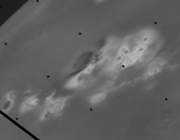
Surt (volcano)
Encyclopedia

Volcano
2. Bedrock3. Conduit 4. Base5. Sill6. Dike7. Layers of ash emitted by the volcano8. Flank| 9. Layers of lava emitted by the volcano10. Throat11. Parasitic cone12. Lava flow13. Vent14. Crater15...
on Jupiter's
Jupiter
Jupiter is the fifth planet from the Sun and the largest planet within the Solar System. It is a gas giant with mass one-thousandth that of the Sun but is two and a half times the mass of all the other planets in our Solar System combined. Jupiter is classified as a gas giant along with Saturn,...
moon
Natural satellite
A natural satellite or moon is a celestial body that orbits a planet or smaller body, which is called its primary. The two terms are used synonymously for non-artificial satellites of planets, of dwarf planets, and of minor planets....
Io
Io (moon)
Io ) is the innermost of the four Galilean moons of the planet Jupiter and, with a diameter of , the fourth-largest moon in the Solar System. It was named after the mythological character of Io, a priestess of Hera who became one of the lovers of Zeus....
. It is located on Io's Jupiter-facing hemisphere at 45.21°N 336.49°W. Surt consists of an oblong volcanic pit (known as a patera), 75 by in diameter, surrounded by reddish sulfur
Sulfur
Sulfur or sulphur is the chemical element with atomic number 16. In the periodic table it is represented by the symbol S. It is an abundant, multivalent non-metal. Under normal conditions, sulfur atoms form cyclic octatomic molecules with chemical formula S8. Elemental sulfur is a bright yellow...
and bright sulfur dioxide
Sulfur dioxide
Sulfur dioxide is the chemical compound with the formula . It is released by volcanoes and in various industrial processes. Since coal and petroleum often contain sulfur compounds, their combustion generates sulfur dioxide unless the sulfur compounds are removed before burning the fuel...
deposits to its south and east. The volcano was first observed in images acquired by the Voyager 1
Voyager 1
The Voyager 1 spacecraft is a 722-kilogram space probe launched by NASA in 1977, to study the outer Solar System and eventually interstellar space. Operating for as of today , the spacecraft receives routine commands and transmits data back to the Deep Space Network. At a distance of as of...
spacecraft in March 1979. Later that year, the International Astronomical Union
International Astronomical Union
The International Astronomical Union IAU is a collection of professional astronomers, at the Ph.D. level and beyond, active in professional research and education in astronomy...
named this feature after an Icelanic
Iceland
Iceland , described as the Republic of Iceland, is a Nordic and European island country in the North Atlantic Ocean, on the Mid-Atlantic Ridge. Iceland also refers to the main island of the country, which contains almost all the population and almost all the land area. The country has a population...
volcano god, Surtr
Surtr
In Norse mythology, Surtr or Surt is an eldjötunn. Surtr is attested in the Poetic Edda, compiled in the 13th century from earlier traditional sources, and the Prose Edda, written in the 13th century by Snorri Sturluson...
.
Several eruptions have been observed at Surt since it was discovered by Voyager 1. The first eruption observed by Earth-based astronomers following the discovery of Ionian volcanism
Volcanism on Io
Volcanism on Io, a moon of Jupiter, produces lava flows, volcanic pits, and plumes of sulfur and sulfur dioxide hundreds of kilometres high. This volcanic activity was discovered in 1979 by Voyager 1 imaging scientists...
took place at Surt on June 11, 1979, between the Voyager 1 and Voyager 2
Voyager 2
The Voyager 2 spacecraft is a 722-kilogram space probe launched by NASA on August 20, 1977 to study the outer Solar System and eventually interstellar space...
flybys. When Voyager 2 encountered the Jupiter system in July 1979, the eruption appeared to have ceased, but a fresh, 600 kilometres (372.8 mi)-wide plume deposit was observed surrounding Surt. This plume deposit was suggestive of an active Pele-type plume at Surt between the two Voyager encounters. In addition, dark material, thought to be lava erupted during the eruption, was visible within the eastern half of the patera. When the Galileo spacecraft first took images of the area in 1996, the appearance of Surt and the surrounding terrain had reverted back to its appearance as seen by Voyager 1, again suggestive of a short-lived eruption.
Surt erupted again on February 22, 2001 in the most powerful volcanic eruption ever observed, in terms of the amount of power (in watts) output by the eruption. The total power output observed at Surt (7.2–8.4 W
Watt
The watt is a derived unit of power in the International System of Units , named after the Scottish engineer James Watt . The unit, defined as one joule per second, measures the rate of energy conversion.-Definition:...
) during this eruption nearly matches the average total power output for all of Io's volcanoes. Despite such a violent eruption, few surface changes were observed in conjunction with the eruption in images acquired by Galileo six months later, suggesting that any changes had largely faded. Fresh, sulfur-rich, reddish deposits were seen in images acquired by Galileo in August 2001 to the northeast of Surt.

